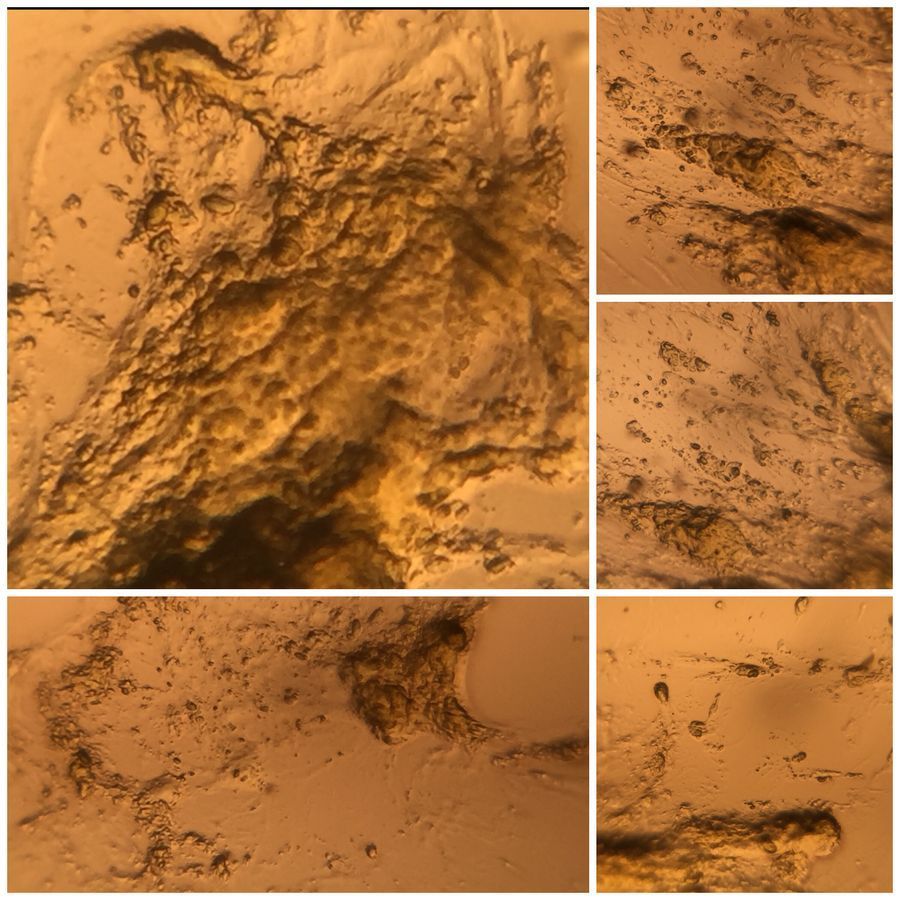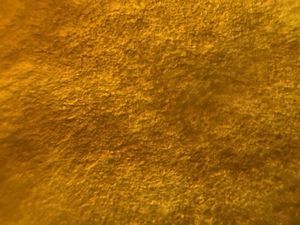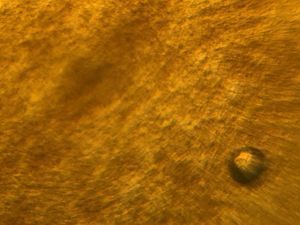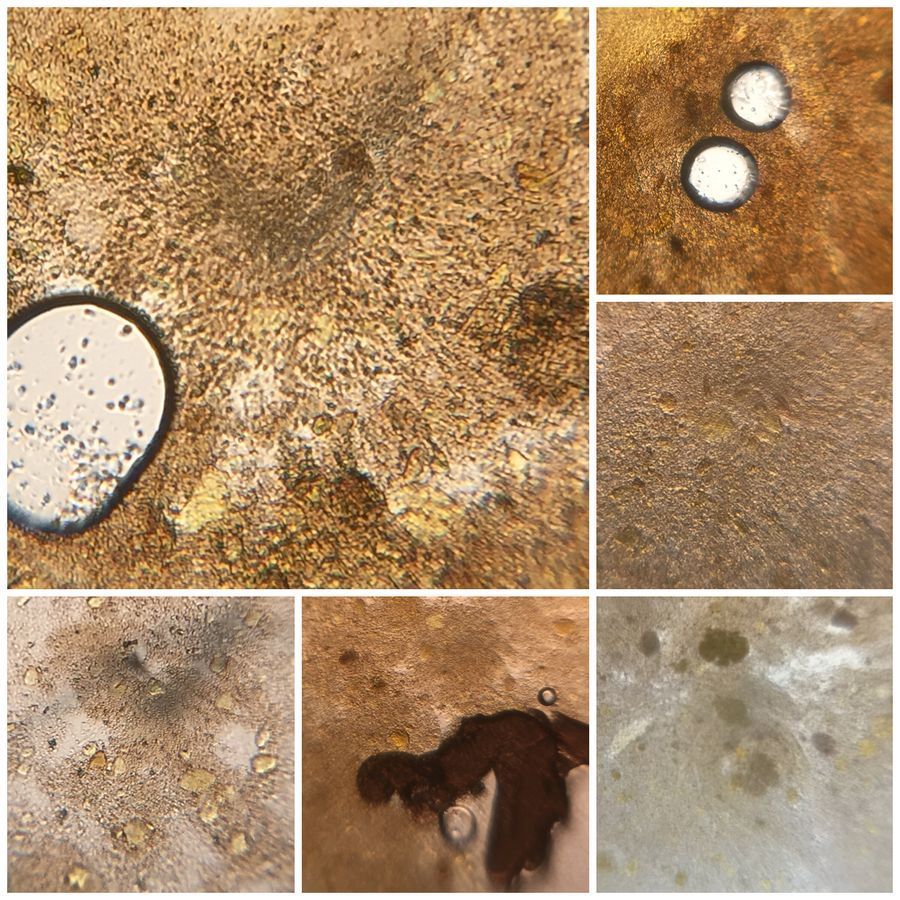Mars or Meconium
 May 10, 2016 • 9:04 AM UTC
May 10, 2016 • 9:04 AM UTC Unknown Location
Unknown Location 140x Magnification
140x Magnification Unknown
Unknown
Manu Prakash
I am a faculty at Stanford and run the Prakash Lab at Department of Bioengineering at Stanford University. Foldscope community is at the heart of our Frugal Science movement - and I can not tell you how proud I am of this community and grassroots movement. Find our work here: http://prakashlab.stanford.edu
266posts
1192comments
42locations

Sometimes, it’s the perspective that matters. Here are a few images I have been taking using my Foldscope of an object that I have to deal a lot with. More on that object/stuff later – but without a scale bar; this might as well be the surface of Mars. Or a newly discovered planet, I am going to name Meconium.

The surface features that you see above, are not mountain tops, volcanoes or valleys. For that matter, they are not surface feature of any planet. They are Meconium – the very “first” bowel movement we all ever pass.
Now Meconium comes out when we have not even had our first meal. But inside the mother, a baby is already drinking the amniotic fluid inside the belly. That and other stuff stays in the gut cavity for months; and passes as the first bowel. It’s strange color – it’s actually black and looks and feels like tar. Very viscous (I wonder how the body is able to pass it). In fact if the first Meconium does not pass out in time; it might be an early indicator of cystic fibrosis; that something is wrong with the cilia.
Here are a few more images of Meconium. Notice the uniform color and lack of any granules. It was previous thought that Meconium is actually sterile; but that view has changed and various species of bacteria already colonize the gut while it’s still developing. Now, where do these early colonizer come from? Meconium is also being used as a diagnostics target – so it’s pretty important stuff.
Now Meconium comes out when we have not even had our first meal. But inside the mother, a baby is already drinking the amniotic fluid inside the belly. That and other stuff stays in the gut cavity for months; and passes as the first bowel. It’s strange color – it’s actually black and looks and feels like tar. Very viscous (I wonder how the body is able to pass it). In fact if the first Meconium does not pass out in time; it might be an early indicator of cystic fibrosis; that something is wrong with the cilia.
Here are a few more images of Meconium. Notice the uniform color and lack of any granules. It was previous thought that Meconium is actually sterile; but that view has changed and various species of bacteria already colonize the gut while it’s still developing. Now, where do these early colonizer come from? Meconium is also being used as a diagnostics target – so it’s pretty important stuff.



You know, if I am going to make a post about baby poop; I have to compare it to a poop that a baby passes; say 10 days old. Here is what it looks like from a 10 days old baby.

It’s messy – what did you expect. It also smells (not so bad though). Stool samples are a remarkable diagnostic target and used around the world for a number of infectious diseases. If you ever thought you got travelers diarrhea – you gave a still sample which was looked under a microscope for Giardia. Last time I got this done; I paid $500 for someone to examine this sample under a microscope. Stool samples are an incredible rich source of information and should be used more often – specially in context of infectious diseases (helminth infections).
Note1: Jim Cybulski from the lab has an exciting study comparing the results for helminth and Shistosomiasis and diagnostics in the field in Kenya. Stay tuned for more.
So back to my post. The overall color of this is not black; green or yellow. And in fact, under the Foldscope – you can see the granular nature of this; specially the green gradual forms. You can clearly see pigment of deep yellow; which gives it the characteristic color yellow. So why does this poop turn yellow you ask – because of Bilirubin.
You have probably heard of Bilirubin in the context of Jaundice. Since my little one’s skin was very yellow – they got phototherapy. What’s fascinating is Bilirubin is just a breakdown component of hemoglobin; what makes your blood red. As hemoglobin is broken down and Iron is reabsorbed – What’s left is Bilirubin. Take a look..
Note1: Jim Cybulski from the lab has an exciting study comparing the results for helminth and Shistosomiasis and diagnostics in the field in Kenya. Stay tuned for more.
So back to my post. The overall color of this is not black; green or yellow. And in fact, under the Foldscope – you can see the granular nature of this; specially the green gradual forms. You can clearly see pigment of deep yellow; which gives it the characteristic color yellow. So why does this poop turn yellow you ask – because of Bilirubin.
You have probably heard of Bilirubin in the context of Jaundice. Since my little one’s skin was very yellow – they got phototherapy. What’s fascinating is Bilirubin is just a breakdown component of hemoglobin; what makes your blood red. As hemoglobin is broken down and Iron is reabsorbed – What’s left is Bilirubin. Take a look..

This needs to be passed in stool; and its collection in the body (if liver function is not optimal) leads to Jaundice. Something that you can see in the baby skin color and in the white of the eye. So Bilirubin is almost heme; but you remove the iron and break the chain – and it turns yellow. So in fact blood and poop share a common story.
Here are a few more images of the regular 10 day old poop.
Here are a few more images of the regular 10 day old poop.



Methods: I simply took a Q-tip and put a drop on a glass slide. I put a cover slip and sealed the same all around. A good deal is useful for working with human samples that can potentially be infectious (although I am not worried about this sample).
Here is the image of the two slides – Meconium is the dark slide.
Here is the image of the two slides – Meconium is the dark slide.

Cheers
Manu
ps: I have been away and have not made posts recently. That’s because I was busy; taking care of two little ones. I am proud to introduce Maya and Mira – young explorers of the microcosmos. Shown below with Foldscope for scale bar.
Manu
ps: I have been away and have not made posts recently. That’s because I was busy; taking care of two little ones. I am proud to introduce Maya and Mira – young explorers of the microcosmos. Shown below with Foldscope for scale bar.


Sign in to commentNobody has commented yet... Share your thoughts with the author and start the discussion!

 0 Applause
0 Applause 0 Comments
0 Comments
















